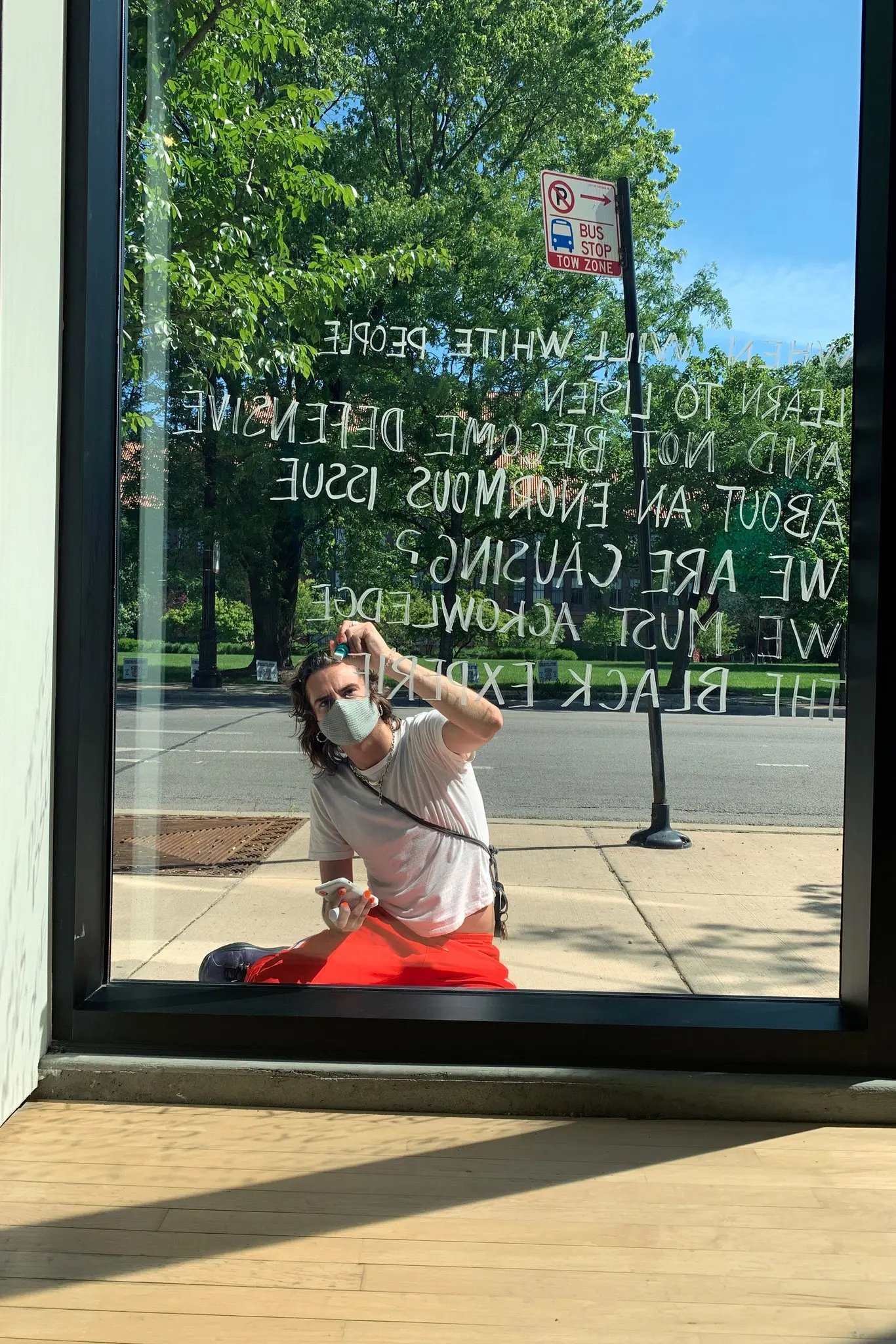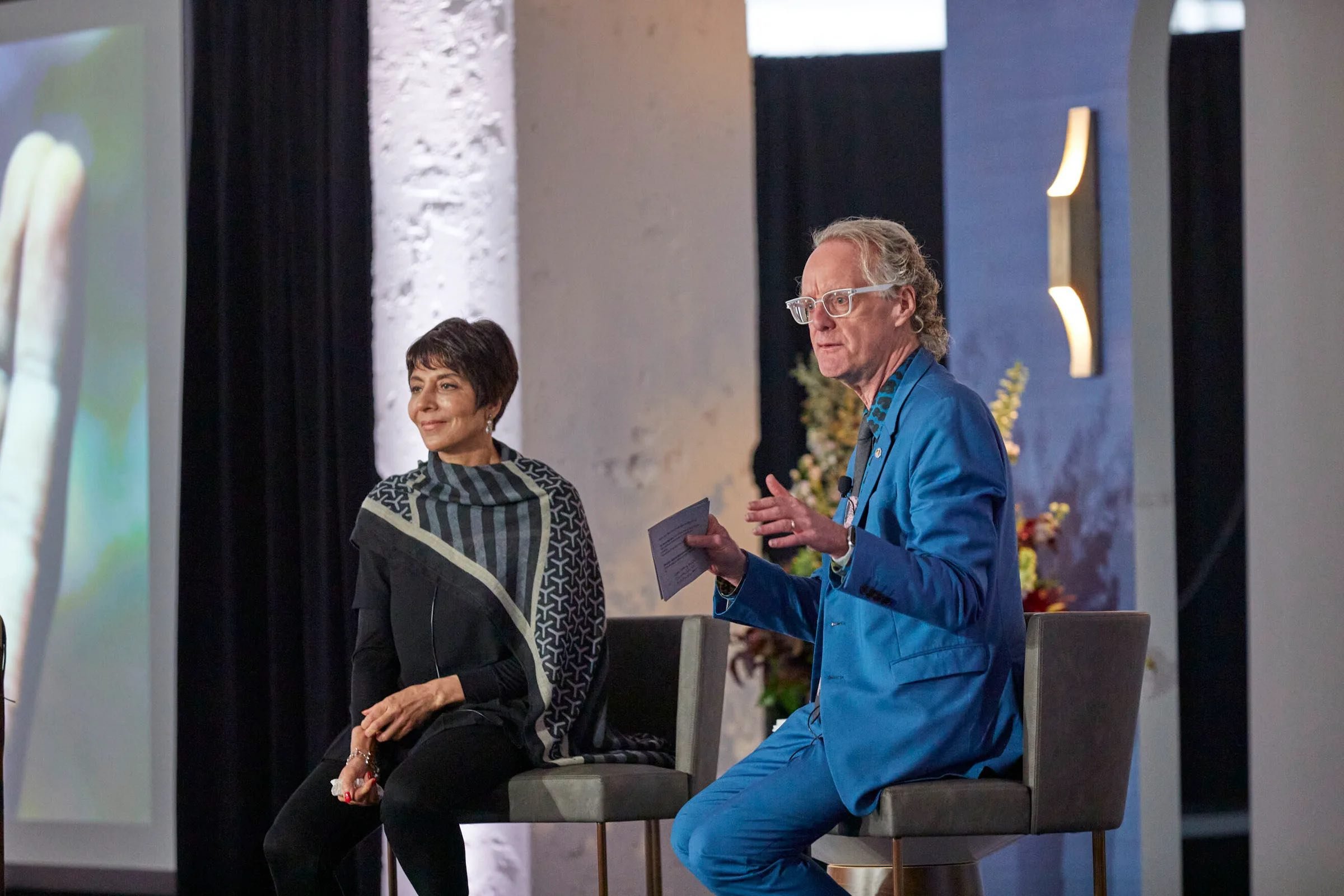NeoCon 2022 Recap Part 2: “Art Has A Job To Do”
Artist Nick Cave and Designer Bob Faust with IIDA’s Executive Vice President and CEO Cheryl Durst © NeoCon
In Part 1 of our NeoCon recap, we explored the foundational values that were driving trends across the showroom floors. In this second part of our recap, we share the impactful insights that came from the thought-provoking and very important keynote talks from an impressive speaker lineup: globally renowned Chicago-based artist Nick Cave and Bob Faust, Principal and Creative Director of Faust; industry-leading multidisciplinary designer Bruce Mau, CEO and Co-Founder of Massive Change Network; and design advocate Shashi Caan, Founding Partner of SC COLLECTIVE.
The common theme across all talks? Designing to elevate the human experience and the world we live in. While that seems like a very lofty goal – well, it is, and it’s also nothing new. But in a time of unignorable social, environmental, and political discourse, the way we design for end users needs to be even more considered, broadened, and empathetic. Each keynote talk spoke to the critical role design plays in creating a better future, no matter how tangible or intangible the problem may be.
Art and Design as Tools for Change
At its core, art is advocacy. It’s storytelling of a perspective that is often the only vehicle of expression for an artist who incorporates layer upon layer of meaning, symbolism, and representation. But the challenge we tend to face in the design industry at large is a shift in the popular mindset about art being purely aesthetic rather than a powerful tool for human connection that can make real impacts on our world. This is what Nick Cave and Bob Faust’s talk Between Art and Design explored the visceral power of art as a way to respond to and be a driver for conversation, education, and reflection during historical social, and political moments.
Letters to the World Toward the Eradication of Racism installation © The New York Times
The duo shared the story of their personal explorations and reflections following the murder of George Floyd, and how their installation series AMENDS became an evolving community piece that furthered uncomfortable conversations, moments of personal reckoning, and brought matters to light in a way that continued this very necessary exploration. As Nick Cave said to Bob Faust after they returned from a Black Lives Matter protest, “If you want to march about it, you have to talk about it” – a phrase that has been featured in AMENDS and now as a part of Cave’s current exhibition Forothermore at the Museum of Contemporary Art (MCA) in Chicago. This sparked a journey and evolution of several interactive art installations, one building off the other, and keeping people talking about racism and the social injustices plaguing the nation and the systems within it.
“If you want to march about it, you have to talk about it” inscribed behind Cave’s Soundsuits installation (right) at the MCA.
This exemplifies the very human experience of what art and design can achieve when creating something in tandem. It gives rise to the notion that art has a job to do; that it exists in a space of service for people who might not even know they need it. It’s our civic responsibility to challenge ideas, explore their meaning, and exist in service of our greater community.
A community member contributing to the installation © The New York Times
Another component of Cave and Faust’s AMENDS installation series entitled “Dirty Laundry” © Ocula
The beauty in Cave and Faust’s living, breathing exhibition is that everyone could identify a way to contribute to the dialogue and add a bit of themselves to it. They could see themselves in it, grow from it, and find their own voice and personal agency within it. The impacts of this work have extended well beyond the physical space in which it stood. That is what makes art so powerful and so important.
Designing For The Future
Bruce Mau at his keynote Bruce Mau on Design © NeoCon
Both Bruce Mau and Shashi Caan did an incredible job highlighting the urgency and importance of using our design practices to shape a better future for our world. Through Mau’s introduction of his 24 principles for designing massive change, he explores how our practice in ‘human-centered design’ must expand to a broader lens of ‘life-centered design’ – design not just for humanity, but for our natural world. In fact, it’s our duty as citizens to give back in the way that nature has given to us.
“We are not separate from, or above, nature.”
- Bruce Mau
It’s easy for any of us to question our ability to actually do the kind of change Mau’s principles speak to, but let’s not forget that he began his career in graphic design, continuing to explore the realms of his work and the impact of design to a place where he now takes on larger-than-life design briefs like redesigning the visitor’s experience of Mecca–a Muslim holy city in Western Saudi Arabia visited by millions arriving for their annual pilgrimage–or rebranding the entire country of Guatemala. We need to shift our thinking into an interdisciplinary lens where all forms of design can come together to instigate important change. What Mau argues is that it’s our duty as designers to inspire–that great design not only solves a particular problem, but also inspires people to solve new ones. It’s also our responsibility to bring fact-based optimism into our work (a belief that characterizes one of his 24 principles).
MC24: Bruce Mau's 24 Principles for Designing Massive Change in your Life and Work © Phaidon
This perspective was also echoed in Shashi Caan’s talk, Design-Ability, whose data-rich keynote spoke to the necessity of optimism to form innovative visions for our built environments and society as a whole. As she puts it, “what inspires us to be better beings, and what supports our work in creating something that builds better for our clients?”
Shashi Caan in conversation with Peter Exley, co-founder of Architecture is Fun and 2021 AIA National President © NeoCon
“What are we communicating? How are we listening? There is so much change but an extraordinary amount of possibility.”
- Shashi Caan
From architecture to interior design to the future of gaming, Caan stressed the importance of vision–and effectively communicating that vision–to be true leaders in the space. This means that we must adopt a mindset where we are creating things that don’t exist yet, but with a rapidly changing world paired with access to information, we have the possibility to create new endless possibilities.
One of the many data-rich slides from Shashi Caan’s keynote
This roundup of talks is inspiring for our industries, and when we view this through the lens of art, how can we continue to carry these ideas forward within the capabilities we have? Each one of these brilliant creatives stressed the importance of interdisciplinary collaboration to fuel future-forward thinking, and every stakeholder who is a part of any design process has a role to play in pushing these ideologies forward. What we can do to further this conversation within the art advisory space is to see how art can continue to amplify conversations and the necessary dialogue about our world, whose voices and experiences we bring to the forefront, how these stories can shape the end user’s experience for the better, and how we can adapt our own practices to walk the talk of important life-centered values. We’re actively in this work already and are excited to see where it takes us as we keep fueling our purpose of changing lives with art. We hope you will be, too.












